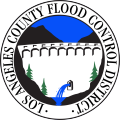HISTORY OF THE LOS ANGELES RIVER
Over ten million years ago, the Los Angeles area was submerged in water. The formation of mountain ranges yielded what is now the San Fernando and San Gabriel Valleys. These areas once drained unconstrained run-off into the Los Angeles basin, providing a topography of shrubs, forests, and dense woods. In recent times with agriculture and development, the River was a major source of water. Early flood control protection developed the River as a channel that conveys water and sediment from mountain slopes during rainstorms.
Los Angeles County is a semiarid region that receives less than fifteen inches of rain per year. Although the County would remain generally dry without the assistance of innovative irrigation systems, some of the surrounding mountainous areas receive more than forty inches of rain per year.
The River and its rich plant and animal habitat provided a livelihood for the Gabrielino Indians, one of the largest group of Indians in North America. Although it is unclear today what this group called themselves, they are referred to as the Tongva. Over 1000 years ago, the Tongva established a settlement on the banks of the River near where Los Angeles City Hall stands today. They were designated by missionaries as the Gabrielino for the Mission San Gabriel in Los Angeles County, and included a smaller group, the Fernandeño for the San Fernando Mission in the San Fernando Valley. Gabrielino territory encompassed much of present-day Los Angeles and Orange Counties, including Santa Catalina, as well as parts of San Bernardino and Riverside Counties.
In 1769, Spanish explorers found more than two hundred Indians at the Yangna site of what is now downtown Los Angeles near Union Station, west of the River. Gaspar de Portolá was the first European to pass through the region, naming the River "Rio de Porciúncula". Later, in 1776, Juan Bautista de Anza led an expedition to establish an exploratory route from Mexico to San Francisco, where he and colonists founded a mission and presidio. As important as the River was to the Gabrielino, it was also a pivotal part of the European existence in California.
The Los Angeles River changed course between flowing west into the Santa Monica Bay along the course of Ballona Creek and flowing south towards San Pedro Bay. The San Gabriel River once emptied into the ocean along the path of the Los Angeles River today. In 1815 the Los Angeles River floods washed away the original Pueblo de Los Angeles. In 1825 a flood caused swamps to be formed between the Pueblo location and the ocean causing the River to flow southerly into its current location. In 1861 another flood caused the San Fernando Valley to flood, washing away riverbanks and water distribution systems. The three Rivers mostly flowed as underground streams with shallow surface streams in the dry season and tremendous flood flows during very wet seasons. By 1904 pumping wells depleted local aquifers at a time when California was the leading agricultural state. William Mulholland, superintendent of the Los Angeles Water company, proposed that Los Angeles area needed other water sources to support its growing agricultural industry and population.
The 1914 flood caused $10 million in damages throughout the developing basin and brought a public outcry for action to address the recurrent flooding problems. The following year, the Los Angeles County Flood Control District was formed. Early flood control efforts included some channelization and the need for reservoirs. Taxpayers approved bond issues in 1917 and 1924 to build the initial major dams. However, taxpayers were not willing to provide enough funds for substantial infrastructure downstream of the dams. After two more destructive floods in the 1930s, Federal assistance was requested and the Army Corps of Engineers took a lead role in channelizing the River. Channelization began in 1938, and by 1960, the project was completed to form a fifty-one mile engineered waterway.
Before channelization of the River, flood control projects and utilization of the River as a source of water changed the system of streams, wetlands, and swamps of the natural lands. Channelization provided flood control for the increasingly developed region and a consistent path for the River course. Today, the banks of the River are almost fully lined along its entire length. Only three portions of the channel bottom remain unpaved: through the Sepulveda Flood Control Basin in the San Fernando Valley, near Griffith Park through Elysian Valley where ground water levels prevent it from being paved, and at the River estuary in Long Beach where the River empties into the Pacific Ocean.
In 1990, Congress authorized funding for the Army Corps of Engineers to study increased flooding along portions of the Los Angeles River. The Corps' study developed into a project for increasing the flood carrying capacity of the lower Los Angeles River, Rio Hondo Channel, and Compton Creek, known as the LACDA Project. When completed, the LACDA Project will prevent flooding from a 100-year rainfall event to over 500,000 people in an 82-square mile area. In addition, the LACDA Project will improve the aesthetics and recreational opportunities along the Los Angeles River and Rio Hondo (LARIO) Trail.
The LARIO Trail system is comprised of 22 miles of bike and equestrian trails along the Los Angeles and Rio Hondo Channel. The LARIO Trail begins near the Whittier Narrows Dam, continues along the Rio Hondo Channel until its confluence with the River, then runs along the River to the Pacific Ocean. The LARIO Trail, maintained by County Departments of Public Works and Parks and Recreation, provides connections to seven parks adjacent to the Los Angeles River and Rio Hondo Channel.


